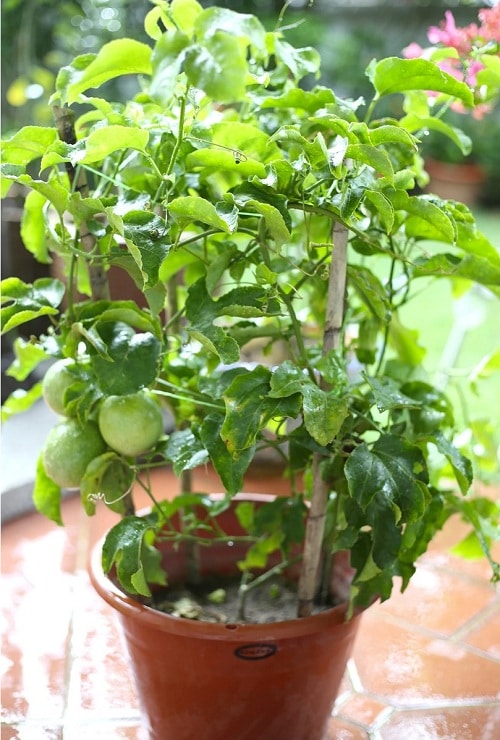Learn How to Grow Passion Fruit in a Pot and have this beautiful fruiting vine in a compact space of your home.
Passion fruit is a popular plant to grow in your garden. It is rich in Vitamins, carotene, and Iron and the best fruit for controlling your thyroid activity. This plant is best kept near a well-lit window or in an outdoor garden. In the lack of sufficient garden space, you can grow this vine in containers. Here, you can learn how to grow passion fruit in a pot.
How to Grow Passion Fruit Propagation

From Seeds
To propagate a Passion fruit vine from scratch, it is best to do so with seeds. Take a few cleaned passion fruit seeds and place them in a starter tray with moist soil. Place them under bright, indirect sunlight. Keep a lid on for the next few weeks as the seedlings start to germinate in the container. As soon as they develop their second set of leaves, transplant them to 4-inch pots and keep them in indirect sunlight as they grow.
From Cuttings
Most of the propagation is usually done through seedlings. But you can use cuttings to create another plant.
While taking cuttings, ensure the plant is healthy and snip a young stem rather than a mature one. Make sure there are 2-3 buds on the stem, and remove any excess leaves at the bottom. Place the freshly cut stem into a moist potting mix immediately and locate it near bright sunlight. Place this new plant in an area with high humidity so the rooting takes place at the right time.
A greenhouse would be ideal, but if you don’t have one, take a tray filled with pebbles and fill it with enough water to reach halfway to each pebble. Place the pot over this tray and ensure the water does not touch the pot. This water will evaporate and cause high humidity around the plant, helping it flourish.
Once the rooting occurs in a couple of weeks, the planting is ready to be transplanted. Move it to a slightly bigger pot and place it near a window that receives a lot of direct sunlight.
Choosing the Perfect Passion Fruit Variety
The best Passion fruit varieties for growing in pots are bush or dwarf ones that do not have extensive root systems. You can choose Possum Purple and Frederick, which have compact growth habits.
Selecting the Right Pot
Use a 5- or 7-gallon plastic pot with drainage holes that provide ample space for roots to expand.
Grow Passion Fruit in a Pot

When you are growing Passion fruit vines in a pot, they need adequate structural support. Always keep 3-foot trellis in the center or 4 feet around the rim. Since they love to climb, let them run free around the support.
When transplanting from cutting or seed, make sure the pot is at least 4-5 inches bigger than the current one so the roots can grow well. If you buy a sapling from the nursery, always handle it with the root ball. Slide the container and place the root ball directly in a rich, well-draining potting mix. Fill in moist soil around the root ball until it reaches the rims of the planter. Water the sapling until water seeps out of the drainage holes. Get rid of the excess water and place your sapling in bright sunlight. Keep it facing southwest so the vine gets complete sunlight.
Under the right conditions, any Passion fruit plant will reach maturity in 2-3 years and start fruiting. The fruits take about 2-3 weeks to become ripe and can then be consumed. The best time to plant a Passion fruit vine is during the Springtime.
Requirements for Growing Passion Fruit in a Pot

Light
Passion Fruit vines prefer direct sunlight unless the temperature is hotter, in which case partial shade is ideal. Always place them near a southwest-facing window so they get the most light.
Soil
The best soil to use for a Passion Fruit vine is one that is rich in nutrients and is well-draining. The pH level has to be between 5-7 so the plant can thrive to the maximum. Make your potting mix with a good ratio of potting soil, perlite, peat, and healthy feed.
Water
Always remember to water regularly while it is growing and fruiting. Water it deeply a couple of times a week and focus on feeding the rooting system, not only the stems.
Fertilization
Apply a slow-release fertilizer rich in phosphorus and potassium at the beginning of spring and summer. Also, organic fertilizers can be used frequently, though avoid overuse as it can cause excessive vegetative growth and no fruits.
Pruning
When the vine grows long, cut back the leading shoots; this will promote lateral growth. For better airflow, prune side shoots to around two leaves. Do remember that after major pruning, the vine needs a short time to recover before producing fruits.
Pests and Diseases
Aphids, spider mites, and scale can attack the plant. To treat these issues, use neem oil or organic sprays. Avoid overwatering and use fungicides if you notice root rot and brown spots.
Harvest
Flowers usually appear in the middle of spring before fruiting in early summer. The Passion fruit vine can flower and fruit in 18 months. Your first fruit will appear around six to eight months after planting the vine. But the best crop will appear after a full 18 months. Passionfruits need to ripen on the vine thoroughly and will fall off when they’re ready to eat.









